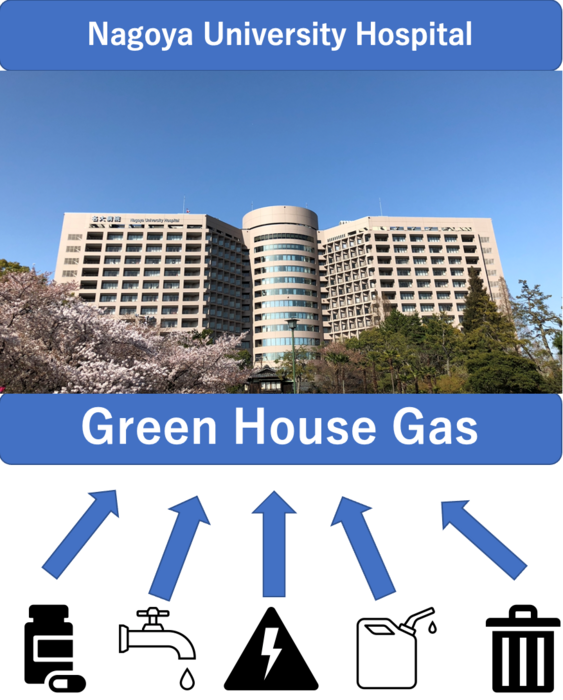In central Japan, a large university hospital with a research center was investigated by a team of scientists who measured the carbon emissions there. They discovered that the hospital’s overall carbon footprint increased over the course of a decade.
 Nagoya University Hospital and the factors that affect its carbon footprint. Image Credit: Takanori Yamamoto
Nagoya University Hospital and the factors that affect its carbon footprint. Image Credit: Takanori Yamamoto
They did also discover, however, that the COVID-19 pandemic saw a decline in gas and electricity-related carbon emissions. The journal Globalization and Health published their research findings.
It is critical to assess the medical sector’s carbon emissions if action is to be taken to address the climate crisis. A significant portion of developed nations’ carbon footprint is caused by the medical industry. For instance, the US healthcare sector accounts for 10% of the country’s overall carbon footprint.
The medical industry is attempting to lower emissions as a result, for example, in the United Kingdom, where the National Health Service aims to achieve carbon neutrality by 2045.
Japan is attempting to lessen its carbon footprint as well. It contributed significantly to global carbon emissions in 2019 as the sixth-largest emitter of greenhouse gases. The national government’s current goal is to cut greenhouse gas emissions by 26% from 2013 levels by 2030. By 2050, the goal is to achieve carbon neutrality.
The COVID-19 pandemic over the previous three years is one aspect that might also have impacted the carbon emissions generated by the medical industry. As a result, it is crucial to both track long-term trends in industrial carbon emissions and assess the effects of shocks brought on by infectious disease outbreaks.
Using data collected from the Nagoya University Hospital and Nagoya University Graduate School of Medicine from 2010 to 2021, a research team led by lecturer Takanori Yamamoto, clinical fellow Hikaru Morooka, and Professor Shoichi Maruyama of Nagoya University Graduate School of Medicine evaluated changes over time in the carbon footprint of a significant Japanese medical institution.
Nagoya University Hospital, one of the biggest hospitals in Japan, is situated in the city of Nagoya. It employs over 2000 staff members and sees over 500,000 patients annually.
The team discovered that over the previous ten years, the global carbon footprint had grown by almost 27%. Electricity use was responsible for about 25% of these carbon emissions.
Despite a decline in gas and electricity-related carbon emissions throughout the study, the hospital’s overall carbon footprint grew. Given that Nagoya University Hospital provides cutting-edge healthcare, the rise in carbon emissions may be due to the increased use of pharmaceuticals and other medical supplies required to treat patients, many of whom are elderly.
The hospital’s carbon footprint increased overall during the study, but it decreased by just over 2% during the first year of the COVID-19 pandemic. In 2020, there were fewer patients, which led to decreases in the use of pharmaceuticals, water, and non-medical waste.
The severity of COVID-19 nevertheless continued to contribute to carbon emissions despite a reduction in the hospital’s overall carbon footprint. Due to the increased need for medical attention during the pandemic, patients’ average hospital stays were longer. Additionally, the rise in patients needing intensive care meant a rise in the carbon emissions produced by pharmaceuticals.
This led to an increase in the monthly carbon footprint per hospital admission, even though the overall carbon footprint decreased between 2018 and 2020. To put it another way, fewer patients meant a smaller overall carbon footprint for the hospital than in previous years, but the severity of COVID-19 meant a larger carbon footprint per hospitalization.
The good news is that hospitals might be able to cut back on the use of drugs that contribute to carbon emissions when the risk of a serious illness is low, and patients do not need hospitalization and intensive care.
The sweltering summers in Nagoya might also be a factor in the hospital’s increased carbon emissions. The carbon footprint of Nagoya University Hospital increased along with the city’s ambient temperature.
The increase in gas and electricity use to keep the indoor temperature comfortable for staff and patients was most likely the root of the problem. Therefore, the carbon footprint of medical institutions is likely to increase with the rising heat from climate change.
There are two important lessons from this research. First, it is urgent to assess the reality of medical carbon emissions because medical staff cannot sacrifice future generations using the excuse of saving present patients.
Takanori Yamamoto, Lecturer, Graduate School of Medicine, Nagoya University
Yamamoto added, “Second, it is important to promote public health measures to reduce future medical demands, because the world is facing an aging society, overtreatment, overdiagnosis and unnecessary visits to hospital. It is crucial to recognize the importance of vaccination and preventive medicine from a sustainable perspective. This research shows both the importance and reality of accurately measuring and evaluating carbon emissions at medical facilities around the world.”
Journal Reference:
Morooka, H., et al. (2022) Influence of COVID-19 on the 10-year carbon footprint of the Nagoya University Hospital and medical research center. Globalization and Health. doi:10.1186/s12992-022-00883-9.